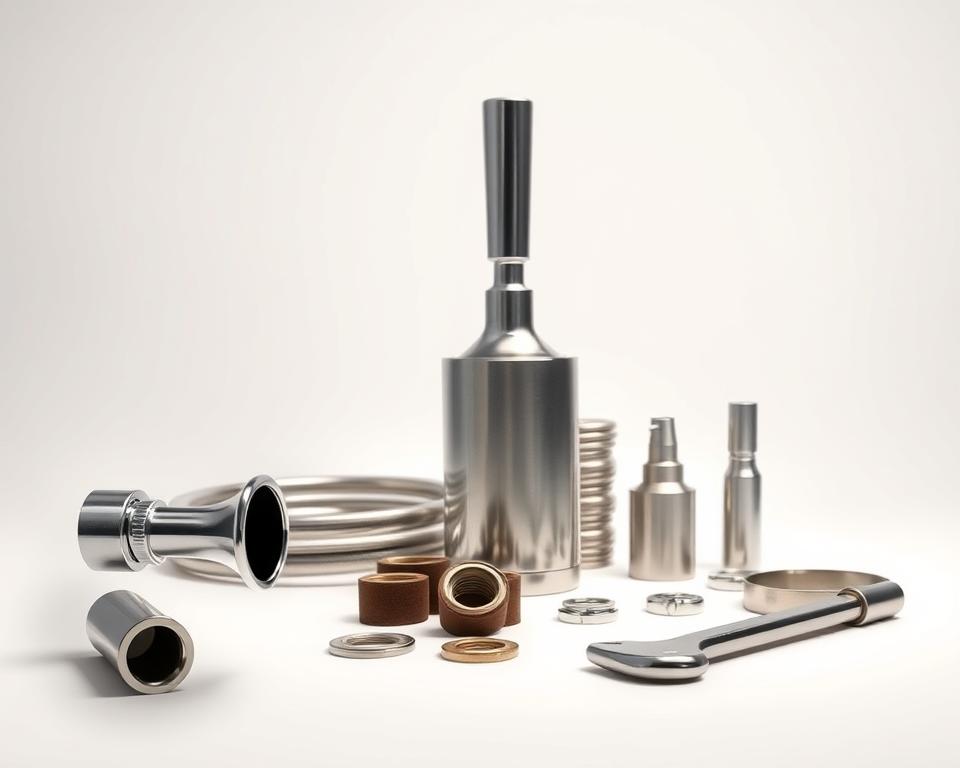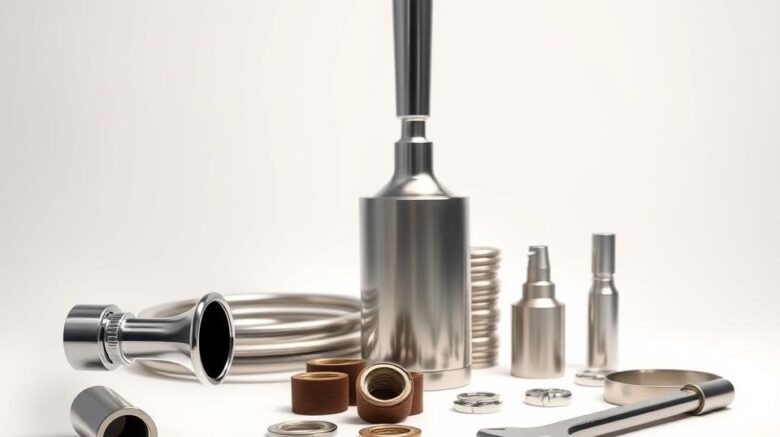Kegerator Coupler Parts: Essential Accessories for Your Home Keg
Ever wondered why your draft beer sometimes pours foamy or flat? Those issues often trace back to the little parts that bridge your keg and tap. Without the right setup, even the best brew can lose its crisp taste and perfect carbonation.
We at Installation Parts Supply believe that every great pour is built on top-notch hardware. No matter if you brew at home or simply enjoy draft beer, knowing these Kegerator parts near me parts makes all the difference.
From washers to gas lines, each part plays a role in maintaining pressure and flavor. Upwards of 90% of pouring problems are due to incompatible or damaged parts. With a bit of know-how, you can keep your setup working without a hitch.
Important Notes
- Choosing the right coupler guarantees ideal flow and taste.
- Installation Parts Supply provides reliable plumbing solutions for draft systems.
- Regular maintenance prevents common pouring problems.
- The style of coupler depends on the beer you’re pouring.
- Coupler faults are behind most draft system breakdowns.

What Is a Kegerator Coupler?
A great pour all hinges on how your keg hooks up to the tap. Think of the keg coupler as the connector between your CO₂ cylinder or nitrogen tank and the beer line, employing pressurized gas to deliver beer flawlessly to your taps. It’s the heart of your draft beer system: no coupler, no flow.
It both pumps gas in to pressurize your keg and regulates how the beer exits. Within its housing is a probe, a check valve, plus dedicated gas and liquid ports. Each part ensures your brew stays carbonated and pours without foam.
| Component | Role | Common Issues |
|---|---|---|
| Probe | Punctures the keg seal | Leaks if not aligned properly |
| Check Valve | Stops beer from flowing backward | Flat pours from worn seals |
| Gas/Liquid Ports | Links to tubing | Loose fittings create foam |
Attaching the coupler wrong is a rookie mistake—75% of first-time users do it. The result? Foamy messes, leaks, or worse, spoiled beer. Check Installation Parts Supply’s charts and videos for correct setup.
Universal designs mean most couplers work similarly, but always match yours to your keg type. Using the wrong coupler can harm both your pour and your gear.
Types of Keg Couplers and Their Uses
Kegs come in many styles and each needs its matching coupler. Using the proper coupler keeps your beer fizzy and flavorful. Here’s how to pick the perfect fit.
Standard D System Coupler
Most North American brews—about 85%—use this style. Its single-valve design locks securely onto most domestic kegs. Quick hint: Find the “Sankey” imprint on it.
Nitro (U) Coupler
Stamped with a harp mark, it’s essential for nitro-charged stouts. A 75% nitrogen mix gives you that signature creamy foam. A U coupler will not seat on a D-type keg—don’t attempt it.
S System (European Sankey) Coupler
Imports from Europe require this S-system coupler. The left-hand twist prevents mix-ups with D Systems. It’s roughly an inch taller than the U.S. version.
A, G, and M System Couplers
Certain European brews need these specific coupler types:
- A-Type Coupler: Used on Warsteiner & Paulaner barrels. That slider lock never slips.
- G-Type Coupler: Used by UK pubs for Bass and Boddingtons. Britain’s go-to pub coupler.
- M-Type Coupler: Made for Schneider Weisse kegs. Its click-lock ensures it’s seated.
Installation Parts Supply’s chart uses green=D, black=U, blue=S. A Midwest microbrewery saved $3,000 yearly by switching to correct couplers. Always favor exact compatibility over “universal” marketing.
Essential Kegerator Coupler Parts and Their Functions
That perfect pour depends on finely tuned parts. Each component helps maintain carbonation and flow. Let’s break down the key hardware that keeps your system running.
Probe + Return Valve
The stainless steel probe pierces the keg’s seal, controlling beer flow. Quality probes endure three times as many uses. The check valve below prevents backflow and is our most swapped component.
Nut and Washer Assembly
A tight seal starts with the hex nut. Brass suits budgets, but stainless steel resists corrosion. Use nitrile washers in the cold—EPDM fails below 40°F.
| Component | Construction | Key Benefit |
|---|---|---|
| Coupler Probe | SS | Resists wear |
| Return Valve | Food-grade plastic | Prevents flat beer |
| Hex Nut | Brass or Stainless | Cost-effective & durable |
Gas and Liquid Ports
Gas ports manage 20–30 PSI of CO₂ or nitrogen. Incorrect pressure spells foam issues. Liquid ports work best with 3/16″ ID tubing—1/4″ lines increase turbulence. Rebuild kits with FDA seals simplify maintenance.
Pro Tip: Change seals twice a year or per 50 kegs. A cheap washer swap saves you from a costly rebuild.
Coupler Installation Guide
Install correctly for flawless drafts. Right setup stops foam and leaks. Follow these steps to connect everything smoothly.
Connecting the Coupler to the Keg
Lift the handle and align the coupler’s lugs with the keg’s slots. Rotate until secure but don’t overtighten. Slim models save 4–5″ of headroom.
Use our torque wrench to set nuts at 8-10 ft-lbs. A misaligned probe causes 80% of leaks. Never reuse old washers.
Line Connections
Hook the gas line on with 5/16″ fittings. Apply thread sealant to prevent CO₂ leaks. Use 10-12′ of 3/16″ tubing to balance draft pressure.
| Step | Equipment | Note |
|---|---|---|
| CO₂ Line | Pipe dope | Check with 30 PSI leak test |
| Draft Line | Pipe cutter | Keep ends square for seals |
| Leak Test | Soapy water | Monitor for a full day |
Some setups include apps that track pressure live. One Denver brewpub reduced foam by 40% with our quick-connects. Turn off gas immediately if you spot big leaks.
Common Coupler Problems & Fixes
Nothing ruins a cold beer faster than foam spraying everywhere. Most pouring problems stem from simple fixes once you know where to look. Let’s tackle the frequent headaches and their solutions.
Foamy Beer Solutions
Sixty-eight percent of draft issues are foam-related. Ensure your temp hovers around 38°F to control foam. If it’s too warm, carbonation goes off too quickly.
Then, look over your draft tubing fittings. Soap test any fitting—bubbles point to leaks. Use a wrench to snug loose parts, avoiding over-torque.
- Ball Check Valve may hiss and interrupt flow
- Not sure on PSI? Use this guide:
| Style | CO₂ Pressure | N₂ Ratio |
|---|---|---|
| Lagers | 10–12 | N/A |
| Nitro Stouts | 25–30 | 75% nitrogen |
Loose Coupler Issues
Loose couplers almost always trace back to worn seals. Our data shows O-ring swaps resolve 40% of loose fits. If the face is warped, swap the entire coupler.
For uneven surfaces, try keg shims. A few dollars in shims cures tilt issues. Low-profile models solve clearance problems in compact coolers.
Pro Tip: Keep a five-seal washer kit on hand for emergencies. One Chicago pub trimmed loss by 18% with staff training.
Tank icing means you need to ease off the gas. Defrost before tweaking the relief valve. Digital gauges need yearly calibration for accuracy.
Coupler Cleaning & Care
Clean lines equal better-tasting beer. Residue can dull taste and impede flow. Regular care preserves performance.
Disassembly and Soaking
First, disassemble the coupler. Remove the handle, probe, and check valve. Soak all parts in warm water with 1 oz of PBW per gallon for 15–20 minutes. That will strip away yeast residue and hop buildup.
Installation Parts Supply’s brush set reaches tight spots. Pay extra attention to the ball valve—it’s a common hiding place for gunk. Flush well to prevent soap residue.
Best Coupler Cleaners
Powdered Brewery Wash excels at safe cleaning. Acid cleaners work faster but can damage rubber over time. For commercial setups, ultrasonic systems blast away debris with sound waves.
- Drying: Remove moisture with air or cloth.
- Sanitizing: Follow FDA CFR 117 guidelines—30 seconds of contact time kills bacteria.
- Logs: Use a log sheet to record each cleaning.
UV sanitation guards seals longer. Dispose of alkaline wash properly to protect drains. Routine cleaning maximizes lifespan and taste.
Conclusion
Enjoy crisp, fresh beer by mastering your draft beer system. Choose compatible parts, maintain them well, and install correctly. Installation Parts Supply backs you with expert help and discount rebuild kits.
Did you know? Routine care can extend your equipment’s life by 7 years. Grab the free compatibility guide or sign up for a pro webinar. A quick annual inspection ensures trouble-free operation—just ask their 5-year satisfied customers.
Ready to upgrade? Visit Installation Parts Supply today and raise your home bar game.
